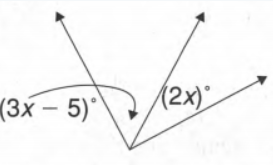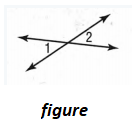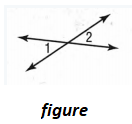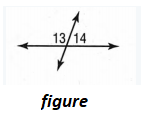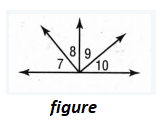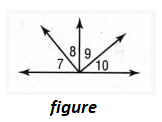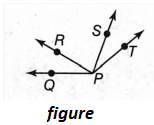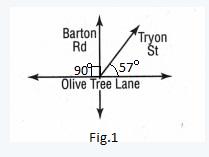HMH Middle School Grade 7 Practice Fluency Workbook 1st Edition Chapter 1 Adding and Subtracting Integers
Page 3 Problem 1 Answer
In the question, the expression is given as 2+(−3). The following number line is given:
![]()
It is required to show the addition on the number line and find the sum.
To solve this, take the first integer given in the expression and show it on the number line.
Use the sign of the second integer to show the addition on the number line and find the sum.
The first integer in the expression 2+(−3) is 2. The second integer in the expression is −3.
Place 2 on the number line and go −3 units to the left to show the addition on the number line.
From the number line, the result of the sum of 2+(−3) is −1, which can be expressed as:
![]()
The addition of 2+(−3) in the number line is shown below:
![]()
The sum of the expression 2+(−3) is −1.
Page 3 Problem 2 Answer
The given statement is −3+4.
It is required to show addition on number line and find sum of given expression.
To do so, simulate the addition on a number line, begin at a point −3 and advance 4 to the right and perform the addition.
Begin at −3 and advance 4 units to the right, as 4 is a positive number.
This gives

Therefore the sum is,−3+4=1.
−3+4=1 is the sum and the representation on number line is given below,

Page 3 Problem 3 Answer
The given statement is,−4+9.
It is required to show addition on number line and find sum of given expression.
To do so, simulate the addition on a number line. Begin at −4 and advance 9 units to the right, as 9 is a positive number and obtain the required sum.
The expression is −4+9.
Consider the number line and then, begin at −4 and advance 9 units to the right, as 9 is a positive number and obtain the required sum.
This gives,

Therefore,−4+9=5.
Thus, the sum obtained is 5.
The sum of given expression −4+9 is found to be 5.
Page 3 Problem 4 Answer
The given statement is,6+(−9).
It is required to show addition on number line and find sum of given expression.
To do so, simulate the addition on a number line. Begin at 6 and advance 9 units to the left, as 9 is a negative number and obtain the required sum.
The given expression is 6+(−9).Consider the number line and then, begin at 6 and advance 9 units to the left, as 9 is a negative number and obtain the required sum.
This gives,

Therefore,
6+(−9)=−3.
The sum of given expression 6+(−9) is found to be −3.
Page 3 Problem 5 Answer
The given statement is,5+(−7).
It is required to show addition on number line and find sum of given expression.
To do so, simulate the addition on a number line. Begin at 5 and advance −7 units to the left, as −7 is a negative number and obtain the required sum.
The expression is 5+(−7).
Consider the number line and then, begin at 5 and advance −7 units to the left, as −7 is a negative number and obtain the required sum.
This gives,

Therefore, 5+(−7)=−2.
The sum of given expression 5+(−7) is −2.
Page 3 Problem 6 Answer
The given statement is,9+(−5).
It is required to show addition on number line and find sum of given expression.
To do so, simulate the addition on a number line. Then, begin at 9 and advance −5 units to the left, as −5 is a negative number.
The expression is 9+(−5).
Consider the number line and then, begin at 9 and advance −5 units to the left, as −5 is a negative number.
This gives,

Therefore,
9+(−5)=4.
The sum of given expression 9+(−5) is found to be 4.
Page 3 Problem 7 Answer
The given statement is,(−1)+9.
It is required to show addition on a number line and find the sum of the given expression.
To do so, simulate the addition on a number line.
Then, begin at −1 and advance 9 units to the right, as 9 is a positive number, and obtain the required sum.
This gives,

Therefore,
(−1)+9=8.
The sum of given expression (−1)+9 is found to be 8.
Page 3 Problem 8 Answer
The given statement is 9+(−7).
It is required to show addition on number line and find sum of given expression.
To do so, simulate the addition on a number line.
Then, begin at 9 and advance −7 units to the left, as −7 is a negative number and obtain the required sum.
The expression is 9+(−7).
Consider the number line and then, begin at 9 and advance −7 units to the left, as −7 is a negative number and obtain the required sum.
This gives,

Therefore,9+(−7)=2.
The sum of given expression 9+(−7) is found to be 2.
Page 3 Problem 9 Answer
The given statement is, 50+(−7).
It is required to show addition on number line and find sum of given expression.
To do so, simulate the addition on a number line.
Then, begin at 50 and advance −7 units to the left, as −7 is a negative number and obtain the required sum.
The expression is 50+(−7).
Consider the number line and then, begin at 50 and advance −7 units to the left, as −7 is a negative number and obtain the required sum.
This gives,

Therefore,50+(−7)=43.
The sum of given expression 50+(−7) is found to be 43.
Page 3 Problem 10 Answer
It is given that there is an expression 1+(−30).
It is required to evaluate the sum of the expression.
To evaluate the expression, consider the number line then, begin to advance from 0 to −30 and then shift 1 places right, then evaluate and obtain the required answer.
The expression is 1+(−30).

Consider the number line and start from 0 to −30 in the negative direction and then shift +1 to the right to represent the required sum on the number line.
Further, evaluate and check the answer.
The expression 1+(−30) is evaluated as,
1+(−30)=1−30
1+(−30) =−29
The sum of the expression 1+(−30) is calculated as −29.
Page 3 Problem 11 Answer
It is given that there is an expression 15+(−25).
It is required to evaluate the sum of the expression.
To do this, consider the number line then, begin to advance from 0 to +15 and then shift 25 places left, then evaluate and obtain the required answer.

Consider a number line and then, begin to advance from 0 to 27 and then shift 6 places left, to obtain the required sum.
The expression 15+(−25) is evaluated as
15+(−25)=15−25
15+(−25) =−10
The sum of the expression 15+(−25) is calculated as −10.
Page 3 Problem 12 Answer
It is given that the outside temperature dropped by 13∘F in seven hours.
The final temperature is recorded as −2∘F.
It is required to find the starting temperature.
To find the starting temperature, assume the starting temperature as x.
Then make an equation showing the difference between the starting and final temperature. Finally, solve for x
in the linear equation and find the value of starting temperature.
Solve the equation obtained in step 1
x−(−2)=13
x+2=13
x=13−2
x=11
The starting temperature outside when temperature dropped by 13∘F in seven hours to −2∘F was 11∘F.
Page 3 Problem 13 Answer
It is given that a football team gains eight yards in one play and then loses five yards in the next play
It is required to find the total yardage from the two plays.
To find the total yardage, add the 8 yards that the team went forward and the 5 yards that they were forced back to gain the total yardage of the team.
It is given that the team went forward 8 yards and came back 5 yards.
Hence the total yardage of the team is given as 8+(−5).
Solve this expression to obtain the total yardage as
8+(−5)=8−5
8+(−5) =3
The total yardage of the football team is calculated as 3 yards.
Page 4 Problem 14 Answer
It is given that there is an expression 3+(−9).
It is required to decide whether this expression is to be added or subtracted and also state the reason.
The expression is 3+(−9).
The expression has the addition operator.
Hence, the two integers will be added.
However, since the nature of the bigger number 9 is negative, the addition operation changes into subtraction and becomes 3−9=−6.
Thus, 3+(−9) results in −6.
The numbers 3,9 in the expression 3+(−9) is to be subtracted as 3−9=−6 because the nature of the bigger number 9 is negative, the addition operation changes into subtraction.
Page 4 Problem 15 Answer
It is given that there is an expression 3+(−9)
It is required to decide whether this expression is to be added or subtracted and also state the reason.
The expression is 3+(−9).
The expression has the addition operator. Hence, the two integers will be added.
However, since the nature of the bigger number 9 is negative, the addition operation changes into subtraction. This can be also defined as adding 3 in −9.
Hence the expression becomes 3−9=−6.
Here, the sum −6 is negative.
The numbers 3,9 in the expression 3+(−9) is to be subtracted as 3−9=−6 and the sum of this expression is negative.
Page 4 Problem 16 Answer
It is given that −2+(−3).
It is required to find the sum of the given integers.
In order to do so, first consider the given integers.
After that, find the difference of their absolute values.
Further, assign the required sign, positive or negative, based on the higher absolute value.
First consider the given integers,
−2+(−3)
Then, determine the absolute values that is,
∣−2∣=2 and∣−3∣=3
So, 2+3=5
The sign of the total has the sign of the terms since the terms are of the same sign. So, the sign of answer will be negative.
Thus,−2+(−3)=−5
The sum of −2+(−3)=−5.
Page 4 Problem 17 Answer
It is given that −5+4.
It is required to find the sum of the given integers.
In order to do so, first consider the given integers.
After that, find the difference of their absolute values.
Further, assign the required sign, positive or negative, based on the higher absolute value.
First consider the given integers,−5+4
Then, determine the absolute values that is,
∣−5∣=5 and∣4∣=4
So, 5−4=1
Since, ∣−5∣>∣4∣, because the sign of the total is the sign of the term whose absolute value is bigger that is 5>4, the sign of answer will be negative.
Thus,−5+4=−1
The sum of −5+4=−1.
Page 4 Problem 18 Answer
It is given that −3+(−1).
It is required to find the sum of the given integers.
In order to do so, first consider the given integers.
After that, find the difference of their absolute values.
Further, assign the required sign, positive or negative, based on the higher absolute value.
First consider the given integers,−3+(−1)
Then, determine the absolute values that is,
∣−3∣=3 and∣−1∣=1
So, 3+1=4
The sign of the total has the sign of the terms since the terms are of the same sign.
So, the sign of answer will be negative.
Thus,−3+(−1)=−4
The sum of −3+(−1)=−4.
Page 4 Problem 19 Answer
It is given that −7+9.
It is required to find the sum of the given integers.
In order to do so, first consider the given integers.
After that, find the difference of their absolute values.
Further, assign the required sign, positive or negative, based on the higher absolute value.
First consider the given integers,−7+9
Then, determine the absolute values that is,
∣−7∣=7 and∣9∣=9
So, 9−7=2
Since, ∣9∣>∣−7∣, because the sign of the total is the sign of the term whose absolute value is bigger that is 9>7, the sign of answer will be positive.
Thus,−7+9=2
The sum of −7+9=2.
Page 4 Problem 20 Answer
It is given that 4+(−9).
It is required to find the sum of the given integers.
In order to do so, first consider the given integers.
After that, find the difference of their absolute values.
Further, assign the required sign, positive or negative, based on the higher absolute value.
First consider the given integers,
4+(−9)
Then, determine the absolute values that is,
∣4∣=4 and∣−9∣=9
So, 9−4=5
Since, ∣−9∣>∣4∣, because the sign of the total is the sign of the term whose absolute value is bigger that is 9>4, the sign of answer will be negative.
Thus,4+(−9)=−5
The sum of 4+(−9)=−5.
Page 4 Problem 21 Answer
It is given that 16+(−7).
It is required to find the sum of the given integers.
In order to do so, first consider the given integers.
After that, find the difference of their absolute values.
Further, assign the required sign, positive or negative, based on the higher absolute value.
First consider the given integers,
16+(−7)
Then, determine the absolute values that is,
∣16∣=16 and∣−7∣=7
So, 16−7=9
Since, ∣16∣>∣−7∣, because the sign of the total is the sign of the term whose absolute value is bigger that is 16>7, the sign of answer will be positive.
Thus,16+(−7)=9
The sum of 16+(−7)=9.
Page 4 Problem 22 Answer
It is given that −21+11.
It is required to find the sum of the given integers.
In order to do so, first consider the given integers.
After that, find the difference of their absolute values.
Further, assign the required sign, positive or negative, based on the higher absolute value.
First consider the given integers,−21+11
Then, determine the absolute values that is,
∣−21∣=21 and∣11∣=11
So, 21−11=10
Since, ∣−21∣>∣11∣, because the sign of the total is the sign of the term whose absolute value is bigger that is 21>11, the sign of answer will be negative.
Thus,−21+11=−10
The sum of −21+11=−10
Page 4 Problem 23 Answer
It is given that 3+(−9).
It is required to find the sum of the given integers and how to know if the sum is negative.
In order to do so, first consider the given integers.
After that, find the difference in their absolute values.
Further, assign the required sign, positive or negative, based on the higher absolute value.
First consider the given integers,3+(−9)
Then, determine the absolute values that is,
∣3∣=3 and∣−9∣=9
So, 9−3=6
Since, ∣−9∣>∣3∣, because the sign of the total is the sign of the term whose absolute value is bigger that is 9>3, the sign of answer will be negative.
Thus, 3+(−9)=−6
Hence, the sum is negative.
The sum of 3+(−9)=−6 and the sum is negative.




